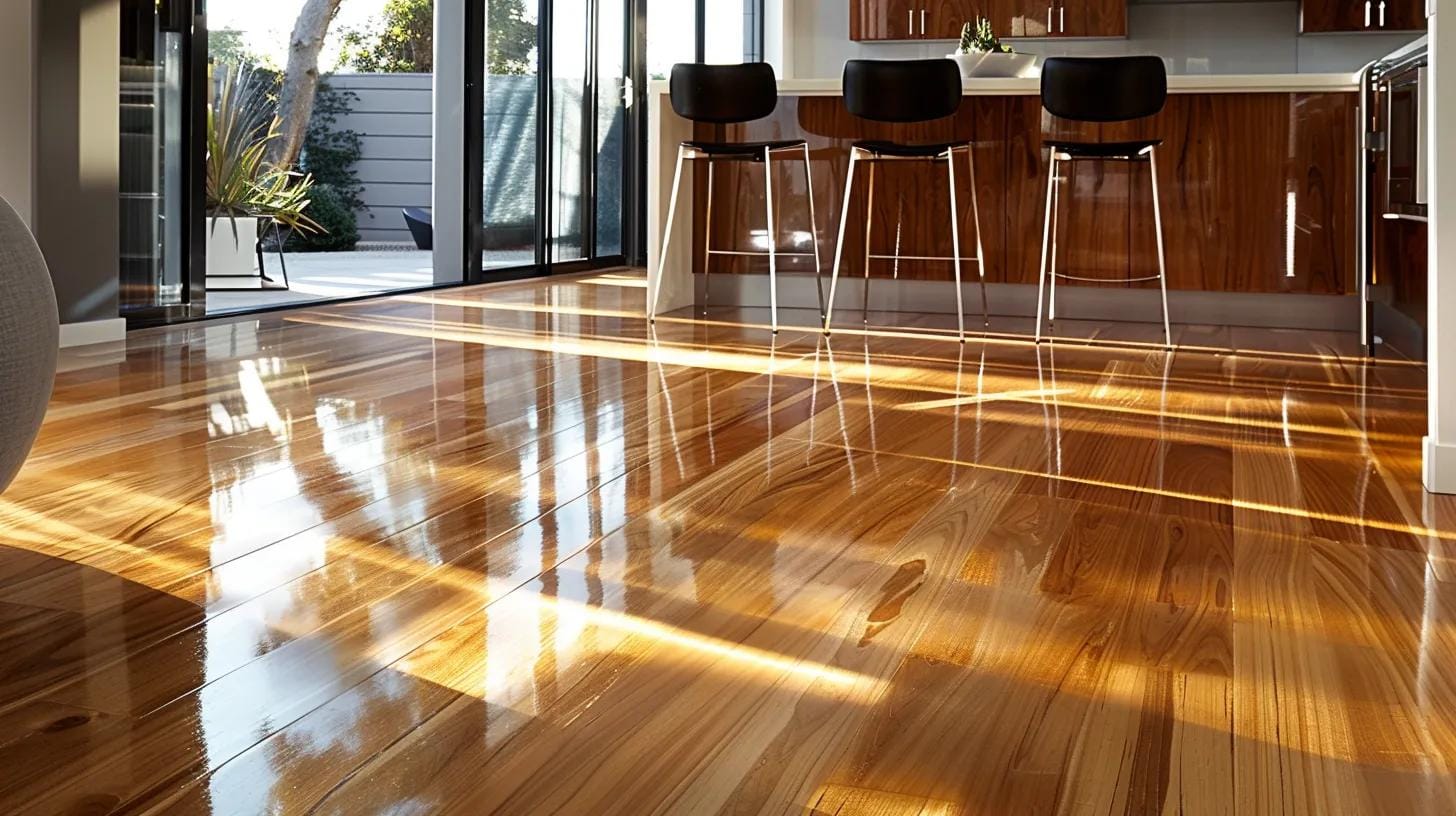Choosing the right flooring for your kitchen can be tough, especially with so many options like hardwood and ceramic. Did you know that waterproofing is a key factor in prolonging the life of your flooring?
In this post, you’ll learn how to evaluate your kitchen space, compare different materials, and understand the maintenance needs for each type.
By the end, you’ll be equipped to make an informed choice about the kitchen flooring options that balance style and functionality, helping you avoid costly mistakes and ensuring your kitchen looks great for years to come.
Top Kitchen Flooring Options: Find the Perfect Style for Your Home
Evaluate Your Kitchen Space When Selecting Flooring Options
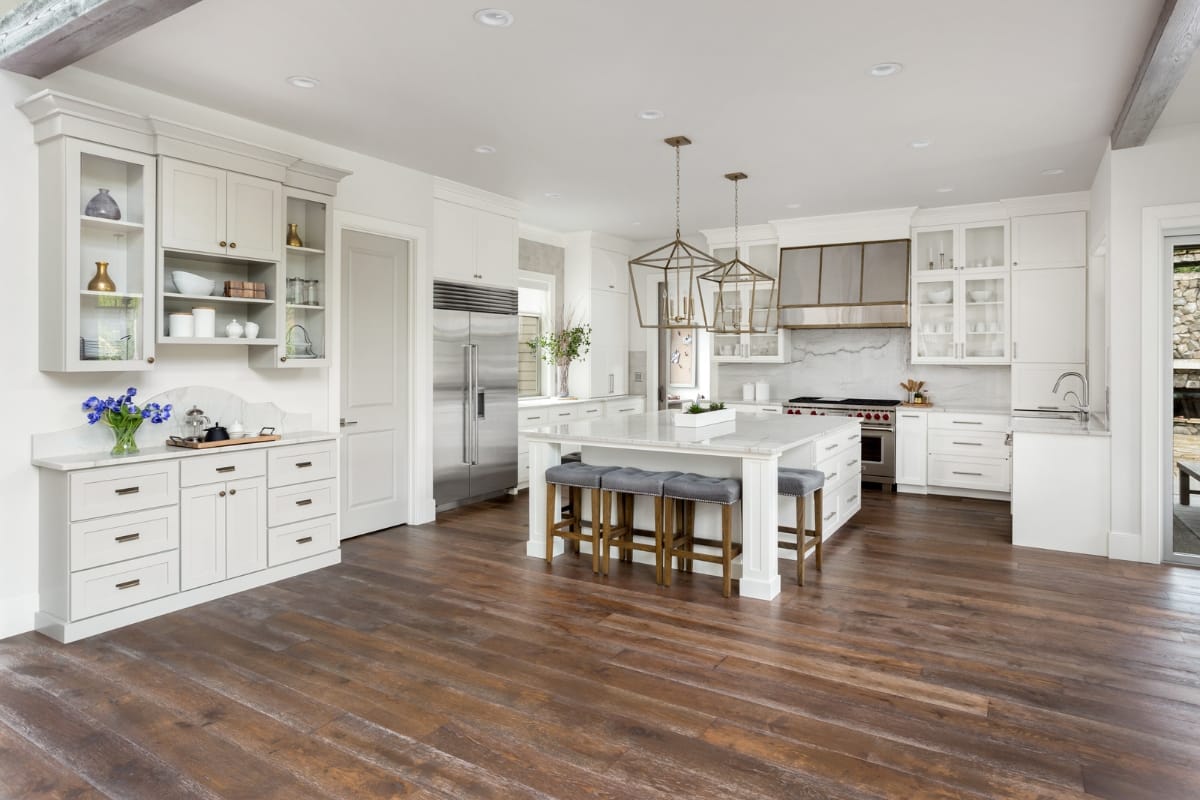
When you’re picking flooring for your kitchen, start by identifying your layout and design style. It’s also vital to measure your space accurately and consider how much foot traffic the area gets.
You should assess natural light and how colors might influence your choices, keep in mind any existing plumbing or cabinetry, and set a clear budget to guide your decision between options like wood, sheet vinyl flooring, or rock.
Identify the Kitchen Layout and Design Style
When considering your kitchen‘s layout and design style, think about how you use your space daily. For example, if you have a busy kitchen, you might prefer durable flooring like porcelain tile or engineered wood, which can resist wear and water damage.
Choosing a design that matches your style while being practical ensures you enjoy your kitchen for years to come.
Your design style can influence flooring color and material choices, so keep this in mind as you plan. If your kitchen boasts a modern aesthetic, sleek porcelain tile might fit perfectly, while a more traditional space could benefit from the warmth of engineered wood.
By aligning your flooring with your overall kitchen theme, you’ll create a harmonious environment that enhances both functionality and beauty:
| Kitchen Layout | Flooring Options | Benefits |
|---|---|---|
| Open Concept | Porcelain Tile | Durable, water-resistant, easy to clean |
| Galley Style | Engineered Wood | Warmth, good for foot traffic, stylish |
| Traditional | Porcelain Tile | Timeless look, variety in design |
Measure Available Space for Flooring Material
Before choosing your kitchen flooring material, it’s key to measure your space accurately. Knowing the dimensions will help you decide which options work best, whether you’re leaning towards tile, laminate flooring, or even cork.
If you have a smaller kitchen, carpets or linoleum can be great choices as they provide some comfort underfoot while keeping the area feeling spacious.
Consider how the layout influences flooring selection. For example, if your kitchen is busy, durable options like tile or laminate flooring stand out due to their longevity and ease of maintenance.
Measuring for your flooring should include allowing for transitions between the kitchen and adjacent rooms, ensuring everything fits together nicely:
| Flooring Material | Best For | Key Benefits |
|---|---|---|
| Tile | Durability | Stain resistant, easy to clean |
| Laminate Flooring | Cost-effectiveness | Affordable, mimics wood look |
| Cork | Eco-friendly | Comfortable, naturally resistant to moisture |
| Linoleum | Custom design | Variety in colors and patterns |
| Carpet | Softness | Adds warmth and comfort |
Consider Foot Traffic Patterns and Usage
When considering foot traffic in your kitchen, think about how often the space sees use. High-traffic areas demand durable options like slate or concrete, as they can stand up to wear and tear without looking worn over time.
If you frequently cook and entertain, materials like marble countertops offer both style and functionality, but be aware they may require more maintenance to avoid scratches and stains.
Your flooring choice should reflect how you interact with your kitchen. If kids or pets are often in and out, lamination can provide a stylish yet practical surface that’s easy to clean.
Making thoughtful choices based on foot usage helps ensure your kitchen stays not only beautiful but also functional for years to come:
| Foot Traffic Type | Recommended Flooring | Key Features |
|---|---|---|
| High Traffic | Concrete & Slate | Durable, easy to clean |
| Moderate Traffic | Lamination | Budget-friendly, stylish |
| Light Traffic | Marble & Engineered Wood | Beautiful, comfortable underfoot |
Assess Natural Light and Color Influences
When you’re selecting flooring for your kitchen, natural light can significantly impact your choices. If your space receives plenty of sunlight, lighter-colored wood flooring can enhance the airy feel, creating a welcoming atmosphere.
On the other hand, if your kitchen is on the darker side, using a warm, deeper-toned flooring can help create a cozy, inviting space without feeling gloomy.
The color of your flooring also plays a critical role in the overall aesthetics and interior design of your kitchen. For example, pairing light wood flooring with granite countertops can provide a stunning contrast, making both elements stand out beautifully.
Think about how the colors will interact with your existing features and the mood you want to create, ensuring your kitchen reflects your personal style while being functional.
Account for Any Existing Plumbing or Cabinetry
When you’re choosing flooring for your kitchen, don’t forget to consider any existing plumbing or cabinetry. If your kitchen has unique plumbing elements or cabinets made from fiberboard, this can impact your flooring choices.
For instance, if your cabinetry is lower to the ground, you’ll want to select a flooring type that won’t clash with that look or that won’t require raising your cabinets, which could complicate your renovation.
Also, think about how your flooring might interact with other areas in your home, like a basement. If you’re laying down oak or another wood-like material, ensure that it can handle any moisture risks that might come from a basement.
Making these considerations will help you create a cohesive design while ensuring your flooring serves both function and style throughout your kitchen space.
Estimate Budget Constraints for Flooring Choices
When estimating your budget for kitchen flooring, consider the materials that can best withstand wear and moisture. For instance, tile options made from clay are both durable and resistant to water, making them ideal for a bustling kitchen space.
Keep in mind that while certain colors and styles may catch your eye, finding something that aligns with your budget will help you manage costs effectively without sacrificing quality or appearance.
Another essential factor is how your flooring choice will complement existing elements like your kitchen cabinet. Opting for a color that harmonizes with your cabinetry can elevate the overall look of your kitchen, but be sure to account for installation costs within your budget.
Taking the time to research different flooring options will help you find a stylish solution that’s practical for your lifestyle, ensuring you make the most of your investment.
Now that you’ve looked closely at your kitchen space, it’s time to think about the materials beneath your feet. Let’s compare the different kitchen flooring options to find the perfect fit for your home.
Compare Different Kitchen Flooring Materials
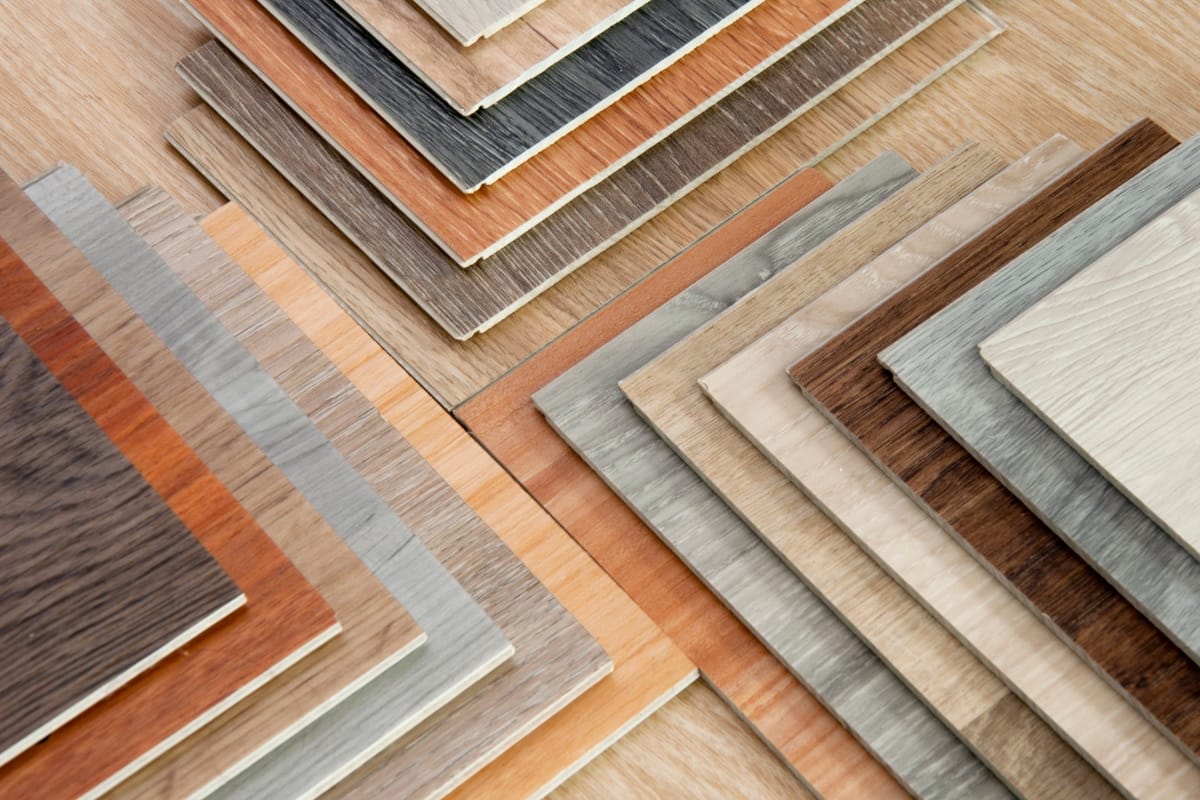
In this section, you’ll look at various kitchen flooring materials to help you make informed choices. First, analyze the appeal of hardwood and discover its beauty and warmth.
Next, review the benefits of tile, including its grout options and resistance to stains. Then, inspect the durability of laminate, evaluate the practicality of vinyl, and examine natural stone choices like limestone for added elegance. Lastly, explore eco-friendly alternatives to create a sustainable kitchen.
Analyze the Appeal of Hardwood Flooring
Hardwood flooring is a popular choice among homeowners looking to enhance their kitchen space. Its classic appeal and natural beauty can complement various cabinetry styles, adding warmth and character to your kitchen.
As an investment, hardwood offers durability, making it a resilient option that can withstand daily foot traffic while maintaining its charm.
When selecting hardwood, consider using plywood as a stable foundation, which can enhance its longevity. Plus, hardwood is an environmentally friendly choice, particularly if you opt for sustainably sourced wood.
This not only contributes to a healthier planet but also ensures your kitchen maintains a fresh and inviting atmosphere for years to come:
| Feature | Hardwood Flooring | Benefits |
|---|---|---|
| Durability | Yes | Withstands foot traffic |
| Investment | High | Long-lasting value |
| Environmentally Friendly | Yes | Sustainably sourced options |
| Foundation Type | Plywood | Enhances stability and longevity |
Review Benefits of Tile for Kitchens
Tile is a fantastic choice for your kitchen flooring, especially if you’re dealing with humidity and dust issues.
Options like travertine and porcelain tiles provide durability and resistance to moisture, making them ideal for bustling kitchens. Not only do they stand up to high foot traffic, but they’re also easy to clean, which is a big plus when you’re managing spills and messes.
Moreover, tile comes in a wide range of designs, allowing you to complement various design styles, from modern to rustic. If you’re a fan of natural materials, you might consider bamboo or slate tiles, which add an earthy vibe to your space.
The versatility in color and texture means you can choose something that fits perfectly with your maple cabinetry, creating a cohesive look you’ll love:
- Durable and moisture-resistant tiles like travertine and porcelain.
- Easy to clean, great for high foot traffic areas.
- Wide range of designs to match your kitchen style.
- Natural materials such as bamboo for an earthy feel.
- Variety in color and texture to complement existing cabinetry.
Inspect the Durability of Laminate Options
When you’re considering laminate flooring for your kitchen remodel, durability is a key factor. Laminate options have improved significantly, making them a strong choice for areas that experience high foot traffic, such as kitchens and even bathrooms during a bathroom remodel.
They can withstand daily wear and tear, resist scratches, and you’ll find that heated spaces don’t compromise their performance, keeping your renovation comfortable and stylish.
Additionally, laminate flooring comes in a variety of finishes and styles, allowing you to achieve the look of hardwood or tile without the hefty price tag.
During your kitchen renovation, remember to choose a high-quality laminate that offers protection against moisture, as this enhances its lifespan. Here’s what you should keep in mind when inspecting laminate options for your space:
- Durability against scratches and dents
- Resistance to moisture for kitchens and bathrooms
- Variety of styles to match your kitchen decor
- Comfort underfoot, even with heated flooring
- Affordability compared to traditional materials
Examine the Practicality of Vinyl Flooring
Vinyl flooring is a strong contender when you’re considering options for your kitchen remodeling project.
Known for its durability, vinyl can handle wear and tear from daily cooking, spills, and foot traffic, making it an ideal choice for busy kitchens. Plus, it comes in various styles and designs, allowing you to match it perfectly with your home improvement vision, all while being budget-friendly.
Another perk is how well vinyl fares against different climates. Whether your kitchen faces high humidity or fluctuating temperatures, quality vinyl flooring resists moisture and stays resilient without deteriorating.
This adaptability not only protects your investment but also keeps your space looking fresh and accommodating for years to come:
| Vinyl Flooring Benefits | Durability | Moisture Resistance | Budget-Friendly |
|---|---|---|---|
| Handles wear and tear from daily use | Yes | Yes | Affordable options available |
| Variety of styles for design flexibility | Resistant to scratches and dents | Maintains quality in various climates | Great for home improvement projects |
Evaluate Natural Stone Choices for Aesthetics
Natural stone options, like hickory and slate, bring a unique beauty to your kitchen flooring. If you want to create a warm and inviting space, consider hickory, a sturdy tree with rich grains that add character.
Stone flooring can handle liquids well, making it practical for busy kitchens while enhancing your home’s overall aesthetic.
Another benefit of natural stone is its variety of colors and patterns, which can complement any design style. Whether you prefer the sleek look of marble or the rustic appeal of limestone, these materials offer endless possibilities.
When choosing your stone, keep in mind the construction quality and how it will interact with your existing elements, ensuring a seamless fit in your remodel:
- Hickory adds warmth and character.
- Slate handles spills effectively.
- Variety in colors and patterns enhances design options.
- Consultation can help with the right choice.
- Consider construction for durability.
Explore Eco-Friendly Flooring Alternatives
If you’re aiming for an eco-friendly kitchen revamp, consider materials like terracotta and cement. These options are not only stylish but also promote sustainability.
For instance, terracotta tiles offer a rustic charm while being made from natural clay, ensuring they have a minimal environmental impact.
Similarly, cement flooring has gained popularity for its durability and low maintenance, fitting perfectly into a modern, sustainable home while enhancing your unique design aesthetic.
Improving indoor air quality is another essential factor when selecting flooring materials. Eco-friendly options often emit fewer volatile organic compounds (VOCs), which can harm your health. By opting for sustainable choices, you create a healthier kitchen environment for you and your family.
Check out resources like HGTV for inspiration on how to integrate these materials into your remodel for a fresh, conscious style that reflects your values.
Choosing the right kitchen flooring is just the beginning. Next, let’s look at how to care for each material to keep your space looking great for years to come.
Understand Maintenance Requirements for Each Material
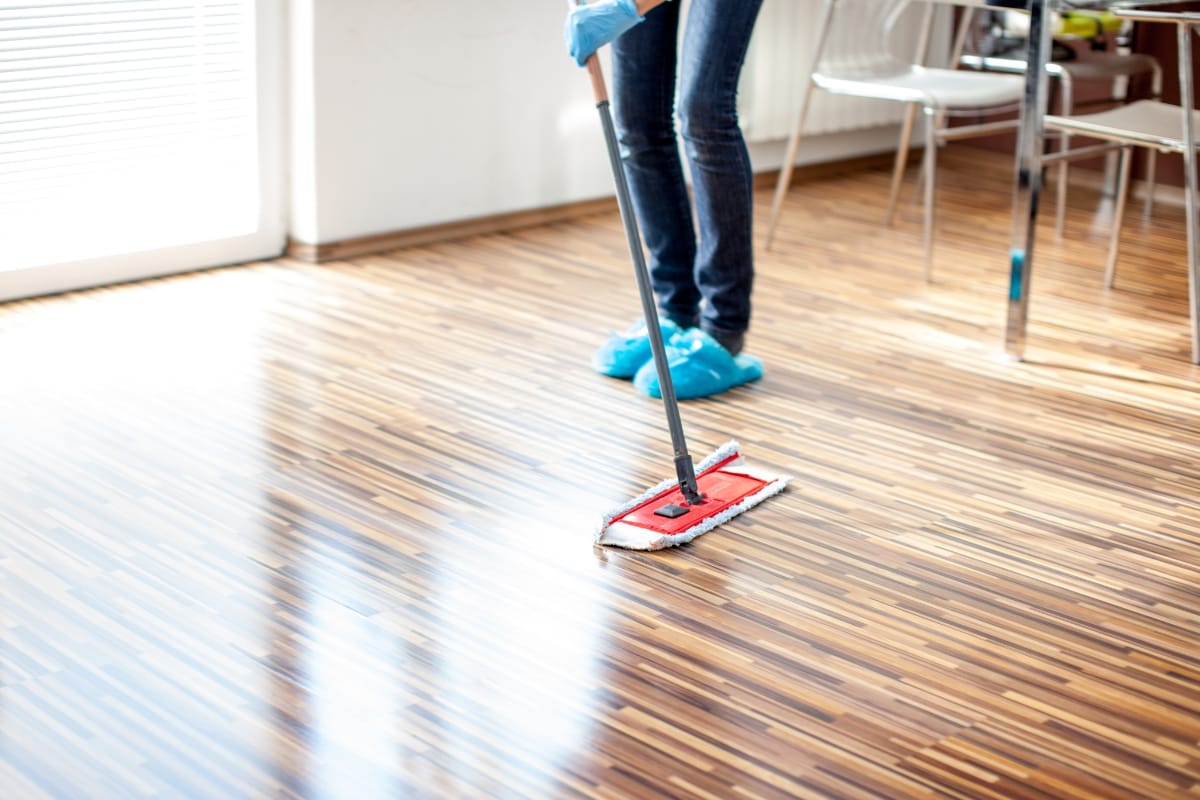
Every kitchen flooring material has its own maintenance needs, which can impact your overall satisfaction and return on investment.
For hardwood floors, you’ll want to outline effective cleaning techniques to keep them looking their best. Tile surfaces require specific care tips to maintain their durability, while laminate needs attention to ensure it remains stylish. Vinyl flooring also has its upkeep routine, and natural stone countertops come with their own long-term care considerations.
Plus, factoring in the costs of professional cleaning services can help your renovation plans align with your real estate goals. Let’s explore the essential maintenance for each material to help you keep your kitchen fresh and inviting.
Outline Cleaning Techniques for Hardwood Floors
To keep your hardwood floors looking great, start by using a soft broom or a vacuum with a wool attachment to remove dirt and debris. This simple step prevents scratches and maintains the integrity of the wood species.
For a deeper clean, mix a few drops of a gentle, plastic-safe floor cleaner with water, and use a damp mop to clean the floors. Avoid soaking them, as excess moisture can damage the wood.
Incorporating routine maintenance makes all the difference. Consider creating a laundry schedule for your cleaning tasks, dedicating a specific day each month for a thorough cleaning with a designated hardwood floor product.
Emphasizing the right hardness in your choice of materials can also help avoid unnecessary wear over time. Regularly maintaining your floors will help you enjoy their beauty for years to come:
| Cleaning Task | Frequency | Best Tools |
|---|---|---|
| Dusting | Weekly | Soft broom or wool vacuum |
| Deep Clean | Monthly | Damp mop with wood cleaner |
| Conditioning | Every 3-6 months | Wood conditioner |
Discuss Care Tips for Tile Surfaces
To keep your tile surfaces in top shape, you’ll want to avoid using abrasive cleaners that can damage their finish.
Instead, opt for a gentle cleaning solution that removes grime without compromising the tile’s longevity. Regularly sweeping or vacuuming will help prevent dirt buildup, which can scratch the surface over time.
When mopping, it’s best to use a cleaner low in volatile organic compounds to maintain a healthy air quality in your kitchen while ensuring a fresh look.
Also, consider the cost of sealing grout lines, as this step can protect from stains and further enhance the durability of your tile floors. By following these care tips, you’ll enjoy beautiful tile surfaces that look great for years to come.
Highlight Laminate Maintenance Methods
Caring for laminate flooring in your kitchen is straightforward and won’t add much to your routine. Start by sweeping or vacuuming to remove dirt, which can scratch the surface if left untouched.
For deeper cleaning, use a damp mop with a gentle cleaner—just avoid soaking the area. Apply linseed oil occasionally to keep the laminate looking fresh and vibrant without damaging it.
If you notice any scuffs or scratches, you can sand the affected area lightly and then apply a laminate repair kit that matches your floor‘s color.
Regular care will ensure that your laminate stays in great shape, making your kitchen space inviting and functional for daily activities. If you have questions or need tips, feel free to reach out via email address for personalized advice.
Review Essential Upkeep for Vinyl Flooring
To keep your vinyl flooring looking fresh and vibrant, it’s important to perform regular upkeep. Begin with a quick sweep or vacuum to remove dirt and crumbs, especially in kitchen areas where cooking happens often.
For deeper cleaning, consider using a damp mop with a gentle cleaner that contains polyurethane, which can help maintain the protective layer of your flooring and prevent scratches that might come from high-traffic areas.
If your kitchen features rich walnut tones, you’ll want to avoid harsh chemicals that may dull its appearance. For spills, a swift cleanup is essential to prevent staining, particularly in busy kitchens where food loves to splatter.
By maintaining your vinyl flooring with these simple tips, you’ll ensure your space remains stylish and functional, perfect for a lively kitchen environment in your California home.
Consider Long-Term Care for Stone Countertops
When caring for your stone countertops, using a quality stone sealer is a game changer. This protective layer not only enhances the beauty of your mosaic design but also helps prevent stains and damage.
As you go through your home construction process, applying the sealer regularly can keep your counters looking brand new for years, making maintenance much easier and ensuring they stand up to daily life.
Cleaning your stone countertops doesn’t have to be complicated. Simply use a gentle adhesive or a pH-neutral cleaner to wipe away spills and messes.
This straightforward approach helps maintain the integrity of the stone while preventing scratches. By taking these essential steps, you can enjoy the elegance of your stone surfaces without the worry of wear and tear.
Identify Costs of Professional Cleaning Services
When considering professional cleaning services for your kitchen flooring, it’s important to understand the costs involved. These services can vary widely based on the type of flooring you have, the level of cleaning required, and your location.
For example, tile and stone floors may require specific cleaning treatments, which could increase the price. You might find that investing in regular professional cleaning can prolong the life of your flooring, saving you money in the long run.
Additionally, think about how often you want to schedule these cleanings. Some homeowners opt for quarterly services, while others prefer a more frequent approach.
Depending on your kitchen‘s activity level, figuring out a cleaning schedule that suits your lifestyle can help you budget effectively. This way, you ensure your kitchen remains a clean and inviting space without breaking the bank on upkeep.
You know the importance of caring for your kitchen materials. Next, let’s look at how comfort and safety in flooring can make your space more livable.
Assess Comfort and Safety Features in Kitchen Flooring
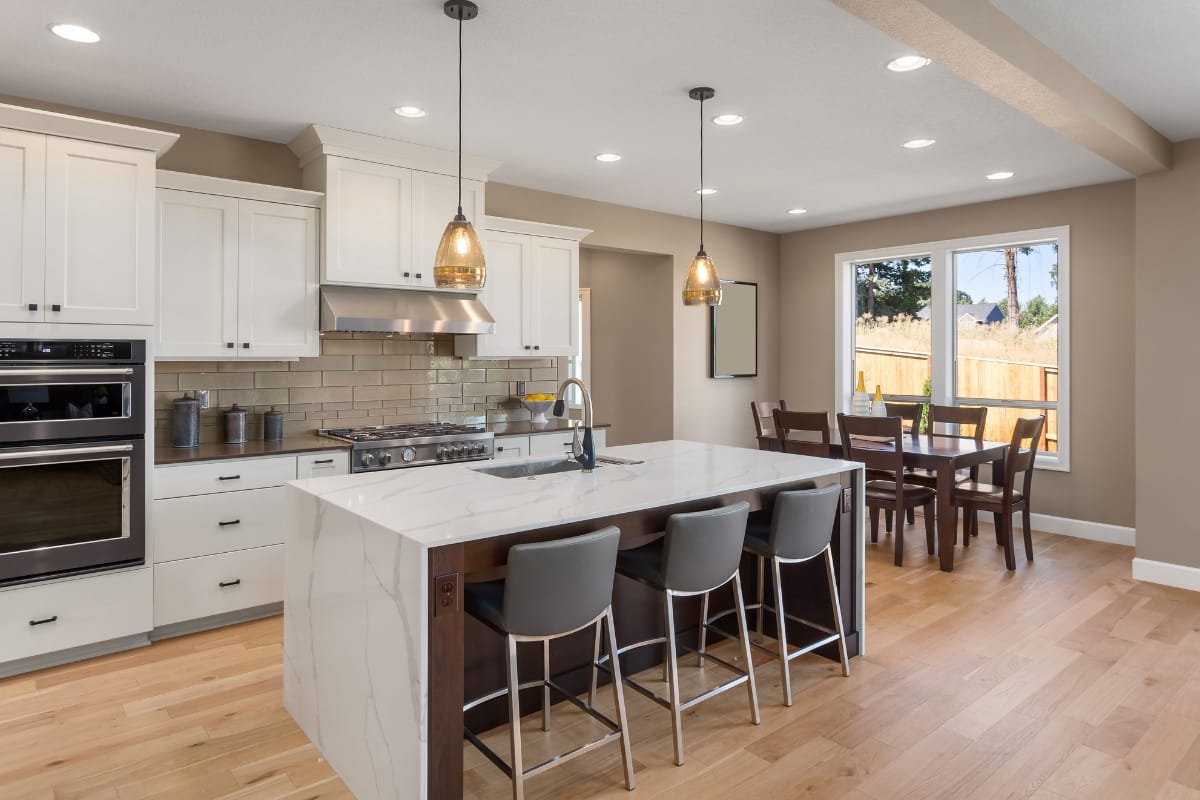
Choosing the right kitchen flooring goes beyond aesthetics; comfort and safety are equally important. Start by exploring the significance of slip-resistant surfaces to reduce accidents.
Look into temperature control aspects that keep your feet cozy, along with cushioning options that make standing for long periods more comfortable.
Also, sound-absorbing materials should be considered for a quieter environment, and chemical resistance in different flooring types should be checked. Lastly, evaluate hypoallergenic options to enhance your kitchen‘s air quality.
Explore the Importance of Slip-Resistant Surfaces
When it comes to your kitchen, safety should always be a top priority, which makes choosing slip-resistant surfaces crucial. A slippery floor can lead to accidents, especially in a busy space where spills are common.
Opting for materials like textured vinyl or slip-resistant porcelain tile can help reduce the risk of slips and falls, giving you peace of mind while you cook and entertain.
Another benefit of slip-resistant flooring is its ability to promote comfort in the kitchen. If you spend a lot of time on your feet, surfaces designed to prevent slipping can also offer better grip and stability, making your time in the kitchen more enjoyable. Think about how much easier cooking becomes when you don’t have to worry about footing issues:
| Slip-Resistant Material | Benefits | Ideal For |
|---|---|---|
| Textured Vinyl | Reduces slipping, easy to clean | High traffic areas |
| Porecelain Tile | Durable, water-resistant | Contemporary kitchens |
| Cork Flooring | Naturally cushioned, warm | Eco-friendly homes |
Identify Temperature Control Considerations
When you’re selecting flooring options for your kitchen, temperature control is something you shouldn’t overlook.
Certain materials can absorb heat, making your kitchen feel too warm in the summer, while others may remain cold and unwelcoming during the winter months. Choosing flooring with better insulation can help create a more comfortable environment, letting you enjoy your kitchen space throughout the year.
Consider using options like cork or luxury vinyl for improved temperature control. These materials are known for their insulating properties, helping maintain a comfortable temperature underfoot. This not only enhances your cooking experience but also contributes to energy efficiency in your home.
By being mindful of temperature control, you’re setting up your kitchen for comfort and functionality, turning it into a space you love using every day.
Discuss Cushioning Options for Standing Comfort
When you’re standing in the kitchen prepping meals, comfort becomes essential. Choosing flooring materials with cushioning properties helps reduce fatigue on your feet and joints, particularly if you’re often cooking or entertaining.
Options like cork or rubber flooring not only provide a soft surface but also contribute to sound absorption, enhancing overall comfort as you move about your kitchen.
Another factor to consider is how well these cushioned flooring options grip the ground. It’s crucial for safety as well—especially if you have kids or pets nearby.
By opting for cushioned surfaces with good traction, you create a more secure environment that makes cooking and cleaning easier and more enjoyable, ensuring your kitchen is a space you love to spend time in.
Analyze Sound-Absorbing Flooring Benefits
Choosing sound-absorbing flooring options for your kitchen can significantly enhance the overall comfort of your space.
Materials like cork or carpet tiles effectively reduce noise levels, making it easier to enjoy conversations or music while cooking. If you often entertain guests, this type of flooring can create a more inviting atmosphere where laughter and chatter flow freely without interruptions from echoing footsteps.
Sound-absorbing flooring also helps with safety in your kitchen. By minimizing noise, you’ll notice reduced distractions, allowing you to focus more on food prep and cooking tasks.
This is especially important if there are kids or pets in the house, as it decreases the chances of accidents occurring. Consider these benefits when transforming your kitchen into a comfortable and safe space:
- Reduces noise levels for a serene environment.
- Improves focus and concentration during cooking.
- Creates a welcoming atmosphere for guests.
- Enhances safety by minimizing distractions.
- Offers a variety of attractive design options.
Review Chemical Resistance of Various Materials
When choosing kitchen flooring, it’s key to consider how different materials handle spills and stains. For instance, vinyl and laminate offer strong chemical resistance, making them excellent choices for busy kitchens where accidents can happen.
These materials can withstand common kitchen substances, like oils and cleaners, ensuring your floors maintain their appearance and integrity over time.
On the other hand, natural stone and certain types of hardwood may require more attention regarding chemical exposure. They can be more susceptible to damage from acidic substances, which might lead to discoloration or etching.
By knowing how well different flooring options resist chemicals, you can make choices that not only enhance your kitchen‘s style but also ensure long-lasting durability and ease of maintenance.
Evaluate Hypoallergenic Flooring Solutions
When you’re freshening up your kitchen with new flooring, consider hypoallergenic options to create a healthier space for you and your family.
Materials like cork, bamboo, and certain types of vinyl are great choices because they are less likely to trap dust, allergens, and bacteria. This means you can enjoy cooking and entertaining without worrying about what’s lurking beneath your feet.
Choosing hypoallergenic flooring not only promotes a cleaner environment but also adds to your kitchen‘s comfort and safety. For instance, cork naturally resists mold and mildew, making it ideal for a bustling kitchen.
Plus, many hypoallergenic options come with soft textures that feel great underfoot, so you can stand and cook for longer periods without discomfort. By opting for these materials, you’re investing in both your well-being and the overall appeal of your kitchen space.
Your kitchen floor should feel safe and solid beneath your feet. Yet, it’s equally vital that it speaks to your taste, setting the stage for the heart of your home.
Factor in Style and Aesthetic Appeal for Your Kitchen
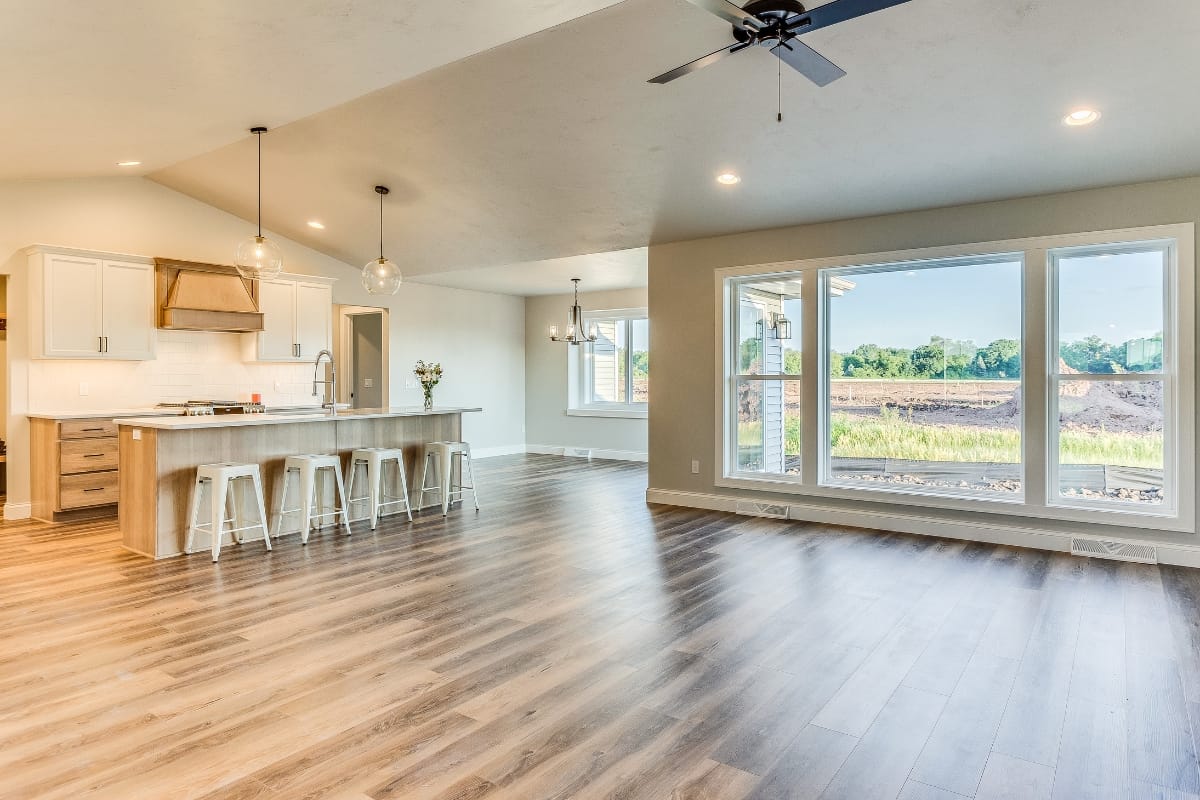
When transforming your kitchen space, it’s essential to factor in style and aesthetic appeal. Start by matching your flooring color with cabinetry and countertops for a cohesive look.
Explore popular trends in kitchen flooring, assess how different patterns can change the perception of space, and identify your personal style choices. You can also consider options for customization and blending various materials to create a unique kitchen that reflects your taste.
Match Flooring Color With Cabinetry and Counters
Matching your kitchen flooring color with cabinetry and countertops can significantly enhance the overall look of your space. Aim for a cohesive palette that ties everything together.
For instance, if you have dark cabinetry, lighter flooring can create a beautiful contrast, making your kitchen feel more open and inviting. On the flip side, if your cabinets are light, a darker floor can add depth and richness, giving your kitchen a modern flair.
When considering color schemes, think about how different shades work together. A muted wood tone in your flooring can complement white or gray cabinets, while bold colors can add personality to a more neutral design.
Additionally, taking samples of flooring and placing them next to your cabinetry can help you visualize the end result, making the decision process much easier. With careful selection, you’ll create a stylish kitchen that reflects your personal taste and functional needs.
Explore Popular Aesthetic Trends in Kitchen Flooring
When updating your kitchen, think about the latest aesthetic trends in flooring that can elevate your space. One popular choice is the use of large-format tiles, which create a seamless look and make your kitchen feel more expansive. Pairing these tiles with neutral tones can provide a classic yet modern vibe that complements any style of cabinetry and countertops.
Another trend worth considering is the combination of various materials to create a unique look. Mixing wood and tile, for instance, can add depth and interest to your flooring design.
This approach not only enhances visual appeal but also allows you to capitalize on the durability of tiles in high-traffic areas while enjoying the warmth of wood elsewhere. Here’s a quick visual breakdown of current flooring trends:
| Trend | Description | Benefits |
|---|---|---|
| Large-Format Tiles | Seamless and spacious appearance | Easy to clean, modern look |
| Mixed Materials | Combining wood and tile | Creates depth, durable in high-traffic |
Assess the Impact of Flooring Patterns on Space
When you’re selecting kitchen flooring, the pattern can drastically change the feel of your space. For instance, herringbone or diagonal patterns can draw the eye and create a sense of movement, making a smaller kitchen feel larger.
If you prefer a more classic look, straight-laid patterns typically lend a clean and streamlined appearance that can enhance the spaciousness of your kitchen.
Think about how different patterns can impact your daily experience in the kitchen. A bold patterned floor can act as a statement piece, injecting personality into the space, while a subtle pattern might complement your cabinetry without overshadowing it.
By considering these elements, you can choose a flooring style that not only enhances the aesthetics of your kitchen but also reflects your personal taste and makes your cooking area inviting.
Identify Personal Style Preferences and Choices
When choosing kitchen flooring, think about your personal style preferences and how they align with the overall design of your space.
For instance, if you lean towards a modern, minimalistic vibe, smooth tiles or sleek laminate might be your best bet. However, if you love a cozy, rustic feel, then warm-toned wood or stylish cork can beautifully complement your kitchen while reflecting your taste.
Your flooring should not only look great but also feel right for you. Consider how often you cook or entertain; this can guide you toward more durable options if your kitchen sees a lot of action.
By selecting a style that resonates with you, you’ll create a space where you not only enjoy cooking but also love spending time with friends and family.
Review Options for Flooring Customization
When it comes to customizing your kitchen flooring, you have a world of options to express your style. Think about incorporating unique patterns or colors that reflect your personal taste and enhance your kitchen‘s aesthetic.
For instance, mixing different flooring materials, like warm wood with sleek tile, can create a distinctive look while maintaining practicality in high-traffic areas.
Another way to customize your flooring is by exploring local artisans who offer handmade tiles or reclaimed wood options. This not only adds character but also supports your community.
Remember, the choices you make should not just look great, but they should also match your cooking habits and lifestyle, ensuring both beauty and functionality in your kitchen space.
Discuss How to Blend Materials for a Cohesive Look
Blending materials in your kitchen flooring can create a seamless and stylish look. For instance, consider pairing durable tile in high-traffic areas with warm wood in more intimate spaces like dining nooks.
This combination not only enhances the aesthetic appeal but also ensures practicality where you need it most, making your kitchen both beautiful and functional.
As you explore different materials, think about how their textures and colors can work together. If you choose sleek porcelain tiles, you might complement them with textured wood or cork to add warmth.
This thoughtful approach to blending allows you to personalize your kitchen while achieving a coherent design that reflects your style and meets your everyday needs.
Your kitchen’s style matters. Next, let’s focus on how to install the right flooring to complement that look.
Learn About Installation Processes for Kitchen Flooring
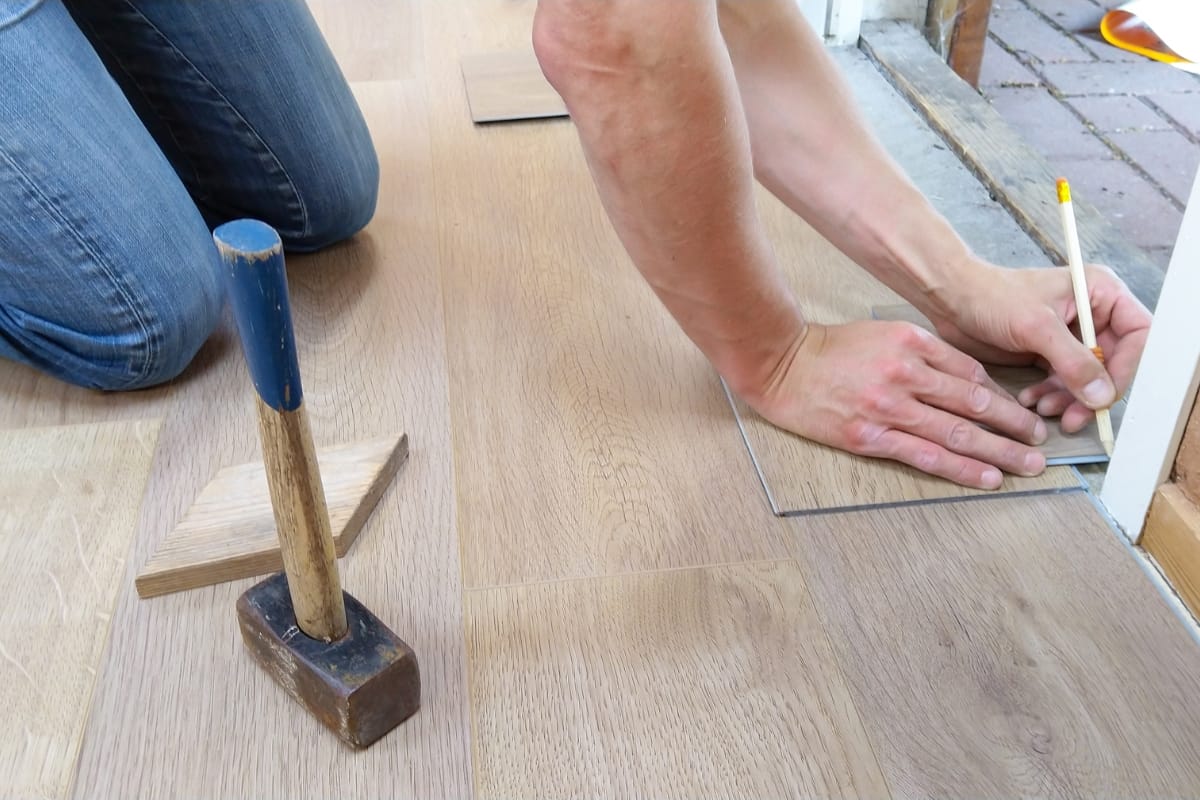
Choosing the right kitchen flooring involves understanding the installation process. You’ll review the differences between professional installation and DIY options, along with the necessary tools and materials for a smooth job.
Additionally, learn about underlayment and preparation needs, steps for a proper flooring layout, and a timeline for project completion. Finally, discover how to care for your new floor and make any necessary adjustments post-installation.
Discuss Professional Installation vs. DIY Options
When deciding on kitchen flooring, you might wonder whether to go for professional installation or tackle the project yourself.
Hiring a professional can save you time and ensure that everything is done correctly, which is especially important for intricate materials like tile or natural stone.
Professionals come equipped with the right tools and experience to handle any unexpected issues that might come up during installation, giving you peace of mind as you transform your kitchen space.
On the flip side, a DIY approach can be a cost-effective way to enhance your space, provided you have done your homework and feel confident in your skills.
Simple flooring options like laminate or vinyl can be great choices for a weekend project, especially if you watch tutorial videos or read guides beforehand.
Just keep in mind that any mistakes can lead to extra costs down the line, so weigh your comfort level with home improvements against the benefits of professional help.
Identify Necessary Tools and Materials for Installation
When you decide to install new kitchen flooring, having the right tools and materials is key to a successful project. Start by gathering essential tools like a utility knife, measuring tape, level, and a hammer.
Don’t forget about flooring-specific tools such as a flooring pull bar and spacers, which help create a professional finish. By being organized with your tools ahead of time, you can streamline your installation, saving you both time and frustration.
In addition to tools, make sure you have all the materials needed for your specific flooring type. If you’re using tiles, you’ll need thin-set mortar, grout, and a trowel for application.
For laminate or vinyl, ensure you have the underlayment and appropriate adhesive if required. Having these materials on hand will prepare you to tackle your project without unnecessary trips to the store, making the installation process smoother and more enjoyable:
| Tool/Material | Purpose |
|---|---|
| Utility Knife | Cut flooring materials as needed |
| Measuring Tape | Ensure accurate measurements of the space |
| Flooring Pull Bar | Perfect for fitting planks snugly |
| Underlayment | Provides cushioning and moisture barrier |
| Thin-set Mortar | Used for adhering tile to the subfloor |
| Grout | Fills gaps between tiles for a finished look |
Examine Underlayment and Preparation Needs
When you’re preparing for kitchen flooring installation, paying attention to underlayment is a must.
Underlayment acts as a cushion beneath the flooring, providing insulation, sound reduction, and moisture protection. Depending on the flooring type you choose, the specific underlayment can vary, so it’s essential to match it to your selected material.
For instance, if you’re laying down laminate flooring, you might opt for a foam underlayment that ensures comfort and stability, making your space feel more inviting as you cook or entertain.
Before installation, make sure your subfloor is clean, dry, and smooth. Any imperfections can affect the look and performance of your new kitchen flooring. Take time to address any repairs needed on the subfloor, as this preparation sets a solid foundation for your chosen materials.
If you’re unsure about the preparation steps or which underlayment is best for your project, consulting with experts can help you navigate these critical decisions, ensuring that your kitchen transformation goes off without a hitch.
Review Steps for Proper Flooring Layout
When you’re laying down kitchen flooring, it’s essential to plan your layout before getting started. Begin by measuring your kitchen space accurately, noting any features like cabinets or fixtures that might affect your flooring design.
Consider marking out the position of your planks or tiles on the floor to visualize how they’ll look once installed, which helps you ensure everything aligns properly and fits seamlessly.
Next, think about the direction in which you want your flooring to run. Aligning tiles or boards along the longest wall can enhance the look of your kitchen and create a sense of spaciousness.
It’s also helpful to start installing your flooring from the center of the room, as this method can create a balanced look and allows for any necessary adjustments along the edges:
- Measure your kitchen space accurately.
- Visualize the layout by marking the position of planks or tiles.
- Decide on the direction for installation.
- Start from the center to ensure a balanced look.
Provide a Timeline for Completion of the Flooring Project
Creating an effective timeline for your kitchen flooring project is crucial for a smooth installation experience. Typically, you can expect the entire process—from choosing materials to final touches—to take anywhere from a few days to a couple of weeks, depending on the extent of the renovation and your specific flooring choice.
For instance, if you opt for tile, allow a few extra days for the adhesive and grout to cure before putting the kitchen back into full use.
To stay organized, break down the project into stages, tracking essential tasks along the way. Start with the selection process, followed by preparation work like clearing the area and ensuring the subfloor is ready. You can use the following outline to keep your flooring project on schedule:
- Select flooring materials and colors.
- Prep your kitchen space: clear out furniture and appliances.
- Evaluate and repair the subfloor if necessary.
- Install the underlayment, if required for your chosen flooring.
- Begin laying the flooring, starting from the center for balance.
- Complete installation and allow for any necessary curing time.
- Move back appliances and furniture, and enjoy your new kitchen!
Discuss Post-Installation Care and Adjustments
Once you finish your kitchen flooring installation, taking the right care of your new space is essential. Start by allowing the flooring to settle for the recommended time before moving furniture back or placing rugs.
This helps avoid warping or shifting, keeping everything in place and looking its best for years to come.
After your flooring has settled, you should regularly perform maintenance to keep it in top shape. For example, sweep or vacuum often to prevent dirt buildup, and use appropriate cleaner products for the specific material.
Being proactive with these small tasks helps you enjoy your stunning kitchen remodel and extends the life of your flooring investment:
| Post-Installation Care Tasks | Frequency | Key Benefits |
|---|---|---|
| Allow Flooring to Settle | Initial Few Days | Prevents Warping |
| Regular Sweeping | Weekly | Prevents Dirt Buildup |
| Use Proper Cleaners | As Needed | Maintains Appearance |
Frequently Asked Questions
What should I consider when evaluating my kitchen space for flooring?
When evaluating your kitchen space for flooring, consider durability, moisture resistance, style, comfort underfoot, and ease of maintenance to find the best option that complements your kitchen remodeling project.
How do different kitchen flooring materials compare in durability?
When selecting kitchen flooring materials, consider options like tile, hardwood, and luxury vinyl. Tile offers excellent durability against moisture and scratches, while hardwood provides warmth but requires maintenance. Luxury vinyl is versatile and resilient, making it a popular choice.
What maintenance is required for popular kitchen flooring options?
Maintaining popular kitchen flooring options like tile, hardwood, and laminate involves regular cleaning, mopping with gentle solutions, and periodic sealing for tile or hardwood to protect against moisture and wear.
Which flooring materials offer the best comfort and safety for kitchens?
When choosing kitchen flooring, opt for materials like cork, vinyl, and rubber for comfort and safety. These options provide cushioning underfoot, ease of cleaning, and slip resistance, making them ideal for busy kitchens.
How can I choose a style that enhances my kitchen‘s aesthetic appeal?
To choose a style that boosts your kitchen‘s aesthetic, consider factors like existing decor, your personal taste, and functionality. Explore options such as modern, farmhouse, or rustic styles to find one that resonates with you.
Conclusion
Transforming your kitchen starts with the right flooring, and Kitchen and Bath by Zeus is here to guide you every step of the way. Whether you’re seeking durability, style, or a combination of both, our expert team is ready to help you select the perfect option to suit your needs and aesthetic.
Call us at 404-602-2668 or fill out our online form to schedule a free consultation for property owners. Let’s turn your dream kitchen into a reality with flooring that stands the test of time!


